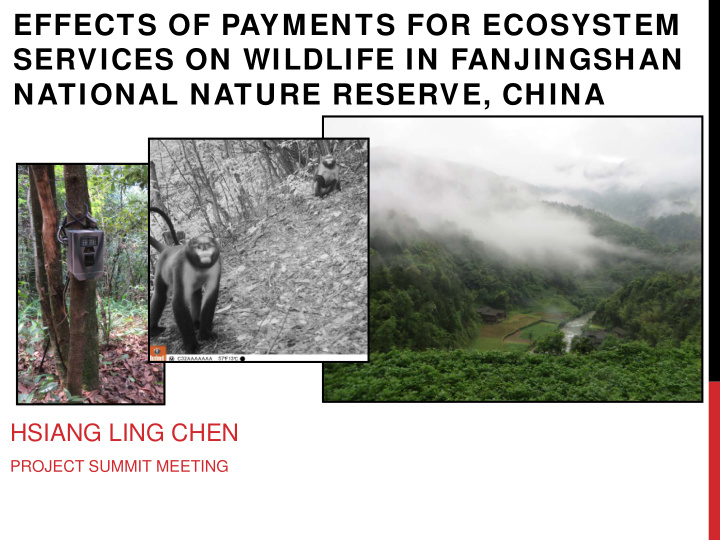



EFFECTS OF PAYMENTS FOR ECOSYSTEM SERVICES ON WILDLIFE IN FANJINGSHAN NATIONAL NATURE RESERVE, CHINA HSIANG LING CHEN PROJECT SUMMIT MEETING
LINK PES TO BIODIVERSITY • Grain to Green Program • From land cover & land use to biodiversity / ecosystem functions • Increased forest cover improved environment higher biodiversity?
RESEARCH GOAL & QUESTIONS Assess ecological outcomes of PES programs and evaluate whether PES programs are beneficial for conservation of biodiversity. • How do environment and human activities affect species richness and occupancy of wildlife? • What are changes in environment and human activities associated with PES programs? • Are PES programs beneficial for conservation of wildlife? • Are land cover & land use good enough for monitoring effects of PES programs?
FANJINGSHAN NATIONAL NATURE RESERVE (FNNR) (41,900 Ha)
FNNR • Elevation: 500 -2500 m • High botanic diversity: ~ 4000 species • Evergreen broadleaf forest to deciduous forest • Local community: 11,000 local residents, > 70,000 tourists, PES • Home to many wildlife species
CAMERA TRAPPING Non PES: 55 sites PES: 16 sites
ENVIRONMENT Forest type Cover Canopy fractional cover (CFC) Understory cover Diversity & richness of plant species - ground, midstory, overstory Forest structure Tree height Diameter at breast height (DBH) Number of tree Topography Slope Aspect Elevation Human activity Signs of human activity Distance to villages Distance to roads Distance to trails
HUMAN ACTIVITY
DATA ANALYSIS Poisson regression – species richness of wildlife (n = 42) Occupancy modeling Survey covariates: camera settings & season Site covariates: environmental characteristics recorded at each plot PES vs. non-PES: differences in environment and human activity (n= 71)
RESULTS- WILDLIFE IN FNNR (0 – 12) • 18 species of medium to large mammals and birds, including the golden monkeys. • 10 species are either protected in China or listed as endangered, vulnerable or nearly threatened on the IUCN Red List.
RESULTS- WILDLIFE IN FNNR • Common species ( > = 20 sites): Elliot's pheasant, Golden pheasant, Hog badger, Temminck's Tragopan, Tibetan macaque, Tufted deer, Wild boar
RESULTS- WILDLIFE IN FNNR • Rare species (< 5 sites): Asian black bear, Chinese ferret badger, crab-eating mongoose, golden monkeys
ENVIRONMENT & SPECIES RICHNESS
ENVIRONMENT &SPECIES RICHNESS • Overall species richness • CFC: positive effect • Presence of livestock: negative effect • Species richness of wildlife with conservation concern • CFC: positive effect • Number of tree: positive effect
WILDLIFE OCCUPANCY 2015/4/17-2016/4/15, 26 surveys, each survey is 2 weeks, single season • Vegetation type: not so important • CFC: influential on occupancy of 7/16 species • Positive : Tibetan macaque, Temminck tragopan, porcupine • Negative : Wild boar, palm civet, weasel, golden pheasant • Plant diversity: not so important • Forest structure: influential but has mixed effects • Human activity: influential on occupancy of 10/16 species • Positive : 3 species • Negative : 7 species
PES VS. NATURAL FOREST 35 PES 30 Non-PES 25 Number of plots 20 15 10 5 0 Bamboo Conifer Evergreen Mixed Deciduous Vegetation Type
PES VS. NATURAL FOREST Environment PES Cover Average no difference, low er variation Plant diversity Low er overstory diversity & richness Forest structure Low er Max. DBH Low er SD. Of DBH Elevation Low er Human activity More signs of human activity Higher detection of human & livestock Closer to roads & village
CONCLUSION • Can PES programs be beneficial for conservation of wildlife? YES! • By increasing CFC, increasing the number of tree, reducing human activity • May provide habitat for some species of wildlife
CONCLUSION Can PES programs be beneficial for conservation of wildlife? YES! • • By increasing CFC, increasing the number of tree, reducing human activity • May provide habitat for some species of wildlife • But…is not restoring original landscape (rehabilitation vs. restoration) • Vegetation types in PES areas are different than natural forest • PES sites are still impacted • Lower species richness of wildlife • Higher human activity • Are land cover & land use enough to monitor effects of PES programs? • Land cover & land use are important as wildlife does respond But…not enough • • To track true ecological effects of PES requires more information on other ecological dimensions
FUTURE PLAN • Papers: • Effects of PES on wildlife biodiversity, community • Effects of human activity particularly livestock on presence of wildlife • Effects of PES on conservation of golden monkeys • Plan (Oct. 2016 – March 2017) • Collecting camera trapping data: Dec. 2016 • Finish most of data analysis for both papers by Dec. 2016 • Submit 1 st paper by the end of Jan. 2017 • Submit 2 nd paper by the end of Mar. 2017
DATA WANTED • Maps of locations of PES (GTGP and NFCP) with attributes obtained by household survey, including time of enrollment of PES (by the end of Oct. 2016) • Information about PES programs in FNNR • Conditions before implementation of PES programs (land cover, land use) • Wildlife observed near farmlands
THANK YOU!
Recommend
More recommend